
Principles
Complexity lens
Clockware/ swarmware
Tune to the edge
Competition/ cooperation
Bibliography
Hurst & Zimmerman: Lifecycle to Ecocycle
From Lifecycle to Ecocycle:
Renewal via Destruction and Encouraging
Diversity for Sustainability
Brenda Zimmerman,
Schulich School of Business,
York University,
Toronto, Canada
| The basic idea: |
Drawing from biological systems, the ecocycle also suggests a need for a
"healthy" organization or system to have parts (or aspects) of the organization
in every phase of the ecocycle. Diversity in the phases of ecocycle is crucial for the
sustainability of a complex adaptive system.
| Potential context for use: |
- To identify things that you should stop doing in order to support the renewal of the work (or of health care)
- To recognize when you are complicit in perpetuating the very things you know need to be stopped
- To redirect energy and reallocate resources to activities that support renewal and change.
- To determine the skills and attributes needed for a management team, board of directors or project team.
- As a contingency framework, to determine which techniques or approaches are needed for different phases of work.
- To encourage diversity in the stages of the ecocycle by recognizing that healthy organizations or systems exhibit all phases of renewal, birth, maturity and destruction.
In this aide, the description
section is used to give some background to the ecocycle concept. The facilitator’s
tips section outlines four specific ways to use the ecocycle in organizations. The
examples section follows the facilitator’s tips and provides two situations where
deliberate use of the model have been helpful for organizations facing major changes in
their environments.
| Description: |
The lifecycle model of
organizations has proven useful to understand the growth and maturity of industries and
organizations. It has been called the S curve in business schools. It depicts the birth,
growth and maturity or a business or industry.
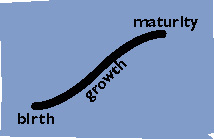
However, the S curve has failed
to address other aspects of living systems: their death and conception, in other words the
phases of destruction and renewal. The model is silent on these aspects of a true life
cycle. The ecocycle extends the lifecycle concept to incorporate these dimensions. The
evolution and sustainability of complex adaptive systems includes the natural and
necessary roles of destruction and renewal. The paradox is that renewal and long term
viability requires destruction.
The ecocycle concept is used in
biology and depicted as an infinity loop. In this case, the S curve of the business school
life cycle model is complemented by a reverse S curve. It is the reverse S curve, shown
below with the dotted line, that represents the death and conception of living systems. In
our depiction of the model, we call these stages creative destruction and renewal. The
importance of the infinity loop is that it shows there is not beginning or end. The stages
are all connected to each other. Hence renewal and destruction are part of an ongoing
process.
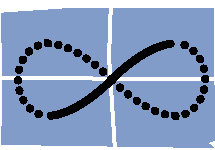
Being an infinity cycle, there is
no obvious start or end to the cycle. Let us begin our examination of the stages at the
beginning of the traditional S curve. We will begin each phase by using the biological
example of a forest and then look at the analogous phase in human organizations.
Principles
Multiple actions
Competition/ cooperation
The
lower left-hand quadrant is the birth and early stage of life phase. This may be an open
patch in a forest. This state is characterized by a wide variety of species all competing
for the resources. There is usually not one dominant species. There are a lot of births in
this stage, however, many of the new births do not reach maturity.
In human organizations, this is
the early "entrepreneurial" phase of an industry or organization. This is a
period of high energy, lots of new ideas and trial and error learning. Resources are
spread over a variety of projects or activities.

In the forest, after a while the
open space becomes crowded, competition starts to require efficiency. Fewer species are
supported as the resources become consolidated or conserved in a few trees that begin to
dominate the space. This maturity or conservation phase is the upper right hand quadrant
on the ecocycle.
In human organizations,
travelling up the S curve from the lower left-hand quadrant to the upper right hand
quadrant has been the mainstay of business wisdom for the past 50 years. Strategic
planning, budgeting and most control systems are designed for this process of
consolidation and improving efficiency. Streamlining operations and allocating resources
with more predictable returns is good management as you move through this phase.
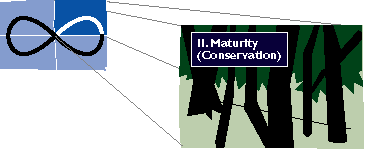
Reflection
Metaphor
We
now move to the reverse S curve as we move to the lower right hand quadrant. This is the
phase of creative destruction or in our forest analogy: the forest fire. The system is not
fully destroyed. But this is not obvious to the naked eye. The burning of the trees and
dead wood releases nutrients and genetic material into the soil to create the conditions
for new growth.
In human organizations, the
creative destruction phase may require dismantling systems and structures that have become
too rigid, have too little variety and are not responsive to the current needs of the
community (or market). An additional level of difficulty in human organizations is the
consciousness of the participants who may cling to the old ways because they were the keys
to success as they moved up the S curve. This can be a very disturbing, unsettling time
for organizations as assumptions need to be exposed and re-examined in light of changing
needs and environments. However, the creative aspect of the creative destruction phase
also indicates the potential for this to be a period of high innovation and new insights.
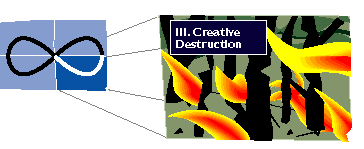
The quadrant in the upper left
completes the reverse S curve and the ecocycle. This is the mobilization and renewal
phase. In a forest, this is the phase after the fire where open spaces have now been
created. The soil is rich with nutrients and the number of possibilities of how these
nutrients will be recombined is very great. It is rich with potential but it is not at all
clear what combinations will be most successful.
Tune to the edge
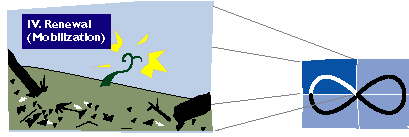
Generative relationships
Stacey matrix
Min specs
Wicked questions
As
the brief description above show, the role of the manager and of the leader change
radically when moving up the S curve as opposed to travelling the reverse S curve. The
lessons from complexity science are highly relevant to travelling the reverse S curve.
Looking at a forest analogy, we
learn several things about the ecocycle. First, a healthy forest exhibits patch dynamics.
In other words, a healthy forest has all parts of the ecocycle in evidence. Some parts of
the forest are dense with mature trees. Other parts are open patches in which life is not
obvious to the naked eye. A healthy forest will have areas of new growth with many
species. Finally, there are parts of the forest which are in periods of destruction
perhaps through a fire, flood or disease.
Patch dynamics are healthy for
forests. Yet they look untidy and a bit disorganized. From an aerial view, the unbroken
blanket of mature trees may be more aesthetically appealing, but history has shown that a
forest in this state is brittle and can be completely devastated by, for example, a fire.
Here is the paradox. The forest needs occasional fires (or other forms of creative
destruction) to renew itself. However, a massive fire can actually damage not only the
trees but also the soil. What this paper is advocating is not a "scorched earth"
policy of wanton destruction. Rather fires or their equivalent in organizations, can be
beneficial if they break down the structures without damaging the soil.
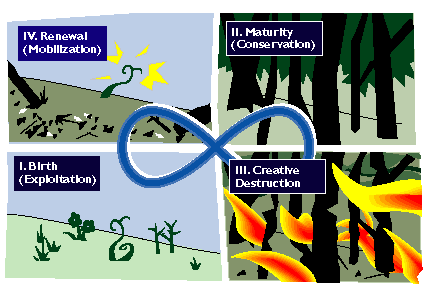
Competition/ cooperation
With
no firebreaks in the forest, there is nothing to stop the path of destruction caused by a
fire. Fire fighters discovered this in the late 1970s and have since changed strategies.
Rather than putting out all fires, they look for situations where they can let a fire
burn. They also deliberately set fires at times. Fire serves as a powerful form of
creative destruction in forests. It burns away the dead wood; it replaces the soil with
needed nutrients and sets the context for the creation of new generations of growth or
even new species. A forest needs to have patchiness to it to ensure its long-term
viability.
The ecocycle uses the concept of
creative destruction and crisis to explain the necessary destruction of forms and
structures periodically to maintain the long-term viability of the overall system. The
word crisis is derived from the Greek krinein meaning to sift. In the ecocycle model, we
think about crises as opportunities to sift so that the unnecessary forms and structures
are removed to enable the substance to be renewed and continue to evolve.
What does this mean for
organizations or human systems? Forms and structures that no longer support the
"work" or the mission of an organization or system need to be destroyed in a
manner that does not destroy the substance. It is a "substance over form"
distinction. Forms and structures are necessary to enable the work to be accomplished but
they are not the essence of the work. In health care, this has become a major issue. The
substance of health care is not the structures of hospitals, clinics or even the
professions of physicians and nurses. Rather these are forms that have enabled health care
work. As enablers, they are crucial but they are not the substance of the work. Forms and
structures must be seen as ephemeral. They support the work but are not the work itself.
Why should health care leaders
learn about this concept? It sounds quite threatening to the medical professions and
institutions. This is a fair assessment, however, it is my contention that this is
happening anyway and it is preferable to be a player in the process to ensure the
substance of health care is not lost but indeed renewed in this period of change. We
return to the paradox mentioned earlier that "fires" can lead to creative
destruction or devastation. Creative destruction is positive and is not synonymous with
devastation where not only are the forms and structures destroyed but the substance as
well. In a forest, a devastating fire has the potential to destroy the trees and the soil.
In these situations, it can take generations before the soil can nurture new life.
Creative destruction is designed to release the nutrients so that new life can indeed
emerge.
In addition, leaders of health
care organizations need to think about whether their organizations exhibit patch dynamics.
Is there enough diversity in the organization to prevent a single "match" from
setting fire to the whole system? Are there firebreaks in the organization? Firebreaks may
take the form of diversity in funding sources so that one funding source cannot determine
the survival or demise of the organization. Firebreaks may also be the
"skunkworks" in the organization, in other words, the parts of the organization
which are trying out new ideas and approaches uninhibited by the "way things are done
here." This is insurance for situations when the community, the funders, the patients
or other key constituents no longer support the "way things are done here".
| Reflection: |
Before using this aide:
Will the group be comfortable using biological metaphors (like a forest) to reflect the issues in your organization?
Will the group see this as an unethical approach? Will they trust that this is a process of honest reflection? Can you demonstrate this by applying the model first to your own context before exposing others to the model?
After using this aide:
How can you move the intellectual discussion of application of the metaphor and model into meaningful action?
| Facilitator's Tips: |
Stop doing and complicity exercise
After a description of the ecocycle, post on a flip chart the following two questions:
What do you need to stop doing to focus on (the nutrients or) substance of your work?
In what ways are you complicit in perpetuating that which you say you must stop doing?
Direct the participants to spend 10 minutes addressing these questions on their own. Then direct them to spend 10 minutes sharing answers with their group. For very large groups, you will need to break them into smaller groups. Have each group post on the flipchart the two "best" answers - one for each category - i.e. one for what you must stop doing and one for how you are complicit.
The definition of "best" has to satisfy the "whoa" test. In other words, what made you sit back and go "whoa"? You don’t have to agree with the "best" you simply have to find one that took you by surprise. Maybe it is controversial, maybe it is gut wrenching, and maybe it is challenging or outrageous.
Post the flipchart on the wall when you are finished. Use these for discussion purposes and coming to some agreement on what the group will stop doing.
It is crucial that the complicity side of the exercise is completed. Without it, it is too easy to say that what must be stopped or changed is someone else’s responsibility or domain. The purpose of the exercise is to uncover how your own actions need to change to enhance the renewal of the work. Recognizing your own complicity in maintaining the status quo is a critical first step.
Substance over form exercise
Suggest individual work for 20 minutes. Since they will not be sharing this with others, they can be brutally honest with themselves.
Take a sheet of paper and draw a vertical line down the middle. On one side of the line write, "form" and on the other write "substance".
Think about your work. What aspects of your work are form and what aspects are substance? As you enter something on the substance side of the page, ask yourself if there is any way this could be form. Could there be something more substantive that underlies it (i.e. try to go as deep as you can on the substance side).
Ask yourself what forms or structures need to be abandoned in order to focus on the core substance or purpose of your work?
Patch dynamics exercise
After a reading of the ecocycle article or a discussion of the need for patch dynamics in the organization, ask the participants to map out the various activities on the organization on an ecocycle diagram.
One way to do this is to identify some of the key activities, programs or projects of the group in question. Have participants put the activities on post-it notes. On a large flipchart draw the ecocycle as background. Post the flipchart on a wall. Direct participants to place their post-it notes on the diagram.
The differences can open up conversations about how people view different programs, their implicit assumptions about the environment and strategic directions.
Have people listen to each other’s ideas and move their post-it notes if their perspectives have changed.
After the discussion has taken its course, say 30-60 minutes, look at the map drawn. Is there a sense of healthy patch dynamics in the organization? Does the map show areas where there is little emphasis? Does this indicate the need to redirect energy and resources in these areas?
Often what happens in this exercise is that an organization will be depicted with a dominance in the mature or conservation phase of the ecocycle. In those cases, it is often useful to reiterate the argument about firebreaks and the need for them as protection against massive devastation. Ask the participants to identify the firebreaks that currently exist in the system. Then ask them how they can put more firebreaks into their system. Ideally, you would like them to identify where these firebreaks are most needed and suggest next steps to implementing them.
Stacey matrix
The problem is that what made
an organization or system successful on the rise from birth to maturity often is the
opposite of what is needed for the creative destruction and renewal phases. The expression
"nothing fails like success" fits here if the management and leadership do not
adjust for the change in the stage of the ecocycle that the organization is facing.
As a facilitator, ask
participants to identify some of their most successful programs or services. Ask them to
map them on the ecocycle. Direct the participants to explain the critical success factors
of the program(s). Then ask them how these critical success factors could become critical
failure factors if the environment changed. Is this happening now? Where? What does this
suggest for alternative management and leadership approaches? (If the alternatives needed
are for more work on the reverse S of the curve, then look to other aides in Edgeware for
guidance or suggestions.)
The purpose of this exercise
is to explore how the success factors of the past can blind you to the needs of the
future.
| Examples: |
In this section, I provide
two examples of the ecocycle aide in practice. The first relates to leaders of
organizations who, using the stop doing and complicity exercise, became
"unstuck" in their leadership role. The second example tells the story of how a
board realized that it needed more capacity for creative destruction and renewal and
deliberately recruited new board members to fulfill this need.
Example 1:
Leaders of social service agencies stop doing and
get moving.
In late November 1996, I
facilitated a meeting with close to 100 leaders of social service agencies. We did the
"Stop doing and complicity exercise." These organizations were facing similar
contexts of decreased government support, increasing demand for their services and
exhausted employees.
In response to "what should
we stop doing", the following are a few of their answers:
- practicing impression management
- taking control of everything
- fighting with funding sources (especially about how to implement programs)
- reacting to negative energy
- being seduced by matters of false importance e.g.
paper work
putting out all the brush fires
negative thinking
old grievances
There was a strong sense in the
meeting that these were common issues across the agencies. Before doing the complicity
side of the exercise, several of the CEOs expressed frustration that these realities were
unchangeable by them.
I then asked them to think
carefully about the lists that had been generated and take a hard look in the mirror to
reveal the ways in which they had been complicit in perpetuating the problems.
In response to in what ways are
we complicit, they generated long lists of ideas. Some of these are listed below:
- rescuing or protecting others from change
- taking things personally
- feeding into negative energy by not countering proactively with something positive
- condoning negativity with silence
- avoiding talking about the real issues (need instead to do the "5 whys")
- assuming too much responsibility
- keeping information to ourselves
- believing I am indispensable to the organization
When we debriefed the exercise,
participants commented that there was a paradox in the complicity part of the exercise.
Recognizing one’s complicity in the problems was humbling but at the same time
energizing. The leaders were all comfortable taking action and yet had felt frozen in many
ways. By recognizing their own part in the problems, they had specific things they could
change. In addition, they commented on how it was great to be thinking about what they had
to stop doing rather than adding to their to-do lists.
Since then, several of them have
spoken to me about the changes they have made. They commented that they are far more
selective about what meetings to attend. They said they find negative energy far less
threatening because they felt they didn’t need to own it or work with it. They also
found their role as leaders had both expanded in scope at the same time as they were more
willing to delegate real responsibility.
Example 2:
An organization brings creative destruction
and renewal to the board.
A board of a nonprofit
organization worked with the ecocycle to reveal what management and governance practices
were needed to address changes in their context. The organization was facing competition
for its services from all three sectors: other nonprofit organizations, government
agencies and for profit businesses. The organization needed to rethink their identity and
role in a context of increasing competition for a shrinking pool of financial resources
and increasing demand for their services in the community.
Wicked questions
Generative relationships
Realizing
that their success to date had been due to skills at riding up the S curve, they saw their
current needs were radically different. One of the changes they made was to change the
criteria for board members. They saw that to go through the creative destruction and
renewal phase, they needed skills in the areas of building generative relationships (often
with organizations and sectors they had not previously interacted with to any great
extent), thinking about the issues systemically, and capacities to make sense of complex
information. They looked for board members who were diverse in backgrounds and experience,
shared a passion for the mission of the organization but were not committed to the
institution itself. These new board members were willing and able to make connections with
people and organizations to rethink how the substance of the work should be done. In
essence, the organization brought the capacity for creative destruction and renewal into
the board.
Principles
Good enough vision
About
three years into this process, the board was faced with a 25% cut to its funding. With the
help of the board and with the explicit use of complex adaptive systems thinking, the
organization survived and has now (almost three years later) returned to its original
size. However, the organization is radically different in form than its predecessor. What
was once one organization is now two. The tasks and programs for the most part are
substantially changed from those offered six years ago. What has remained unchanged is the
focus and passion for child welfare and prevention of social, economic and health problems
for children.
One interesting footnote to this
story, is the organization in question found CAS thinking so valuable for its own
purposes, that one of its new services is a consulting practice for other nonprofit
organizations based on the principles of CAS.
References for further study:
For further elaboration of this
concept see "From Life Cycle to Ecocycle: A New Perspective on the Growth, Maturity,
Destruction and Renewal of Complex Systems," by David Hurst and Brenda Zimmerman, Journal
of Management Inquiry, Vol. 3, No.4, 1994, pp. 339-354
Also see Holling, C.S..,
Simplifying the complex: The paradigms of ecological function and structure. European
Journal of Operational Research, Vol. 30, 1987, pp. 139-146
D.K. Hurst, Crisis and
Renewal: Meeting the Challenge of Organizational Change, Harvard Business Press, 1995
Next | Previous | Return to Contents List
Copyright ©> 2000, Brenda J.
Zimmerman. Schulich School of Business,
York University, Toronto, Canada. Permission to copy for educational
purposes only.